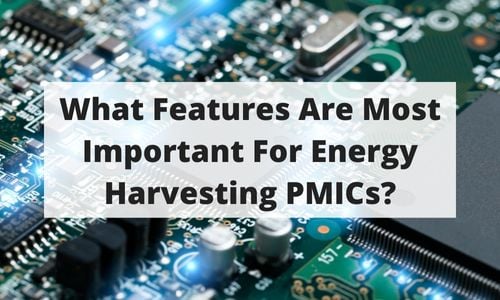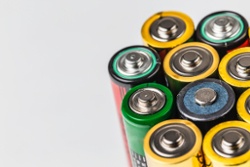
Energy Harvesting Power Management ICs (EH PMIC) are critical components of energy-autonomous electronics. They connect PV, energy storage, and the load ensuring power flows efficiently between all components.
Not all PMICs are the same. Many come with a range of features that make them suitable for different applications or environments, so it can be challenging to pick out what's most important.
Below is a list of the most critical PMIC features you need for solar and light energy harvesting applications.
Take this blog post with you!
Low Voltage Boost

The most important function of an EH PMIC is the ability to boost or step up low voltage power sources, like single-cell PV modules, to a usable system or battery voltage.
A single-cell PV module will not be affected by shading or uneven illumination, which is extremely important for wearable, portable, and indoor devices consistently exposed to irregular lighting conditions.
A PMIC that can boost from 0.8V (single-cell PV) to 4.2V (Li-ion battery) will do the trick for most applications.
Dynamic Power Point Tracking (MPPT)

In many cases, PV modules can damage storage elements or charge inefficiently, or not at all, if left unregulated. A critical function of a PMIC is to regulate the PV module and "hold" it at its maximum power point.
To make things more complicated, the max power point changes with light intensity and temperature. Implementing a dynamic MPPT algorithm ensures you are always collecting the most energy possible from the solar panel under all conditions.
How quickly the MPPT algorithm responds to light level changes can be critical for wearable and portable applications where light intensity changes rapidly and often. A good PMIC will be able to adjust within seconds, with some able to adapt in a fraction of a second.
The version of the MPPT algorithm is also important. Some PMICs offer a true MPPT function where the panel is adjusted based on real power measurements. This method extracts the maximum amount of energy possible out of the PV module under any conditions.
Most EH PMICs implement a ratio-style MPPT function where open-circuit voltage (Voc) is sampled periodically and the panel is held at a set fraction of Voc. This method is an effective way to account for changes in light level and temperature.
Set point MPPT is also common where the panel is held at a fixed point. This method is adequate for fixed outdoor installations with predictable illumination but not recommended for most wearable, portable, or indoor IoT applications.
Quiescent Current and Efficiency

As a PMIC manages the flow of energy between the PV, storage, and load, it must be able to do so efficiently while consuming as little power or quiescent current as possible.
Ultra low power applications often see an average device power consumption of 10uW or less. At this level, every micro-Amp counts.
A good EH PMIC has a total quiescent current under 1uA and boost efficiency in the 85%-95% range depending on input/output voltage requirements.
Cold Start

Cold start is essential for batteryless systems that could completely discharge to 0V.
For these applications, the PMIC must have a cold start feature to initialize charge from a low voltage source, such as a 0.8V PV cell.
Minimum input power is also an essential cold start characteristic. EH PMIC should handle power from small indoor panels that may produce only tens of micro-Watts. Some PMICs can start with as little as 3uW @ 0.38V.
Storage Element Charging and Protection

Finally, charging and protecting a storage element is crucial for an EH PMIC. Most ICs include overvoltage and under-voltage protection.
Overvoltage protection will terminate charging once the storage element is full. Undervoltage protection will disconnect the load once the storage element is empty.
In many cases, these levels are user-configurable or come as preset options, allowing developers to choose their application's best configuration.
Other convenient features include dual cell supercapacitor balancing and primary battery backup.
Wading through the features and options of EH PMICs can be overwhelming, but there are solutions available that have the performance needed for most energy harvesting applications.
Ultimately the right PMIC and feature set depends on your specific application needs.
If you have any questions about PMIC features or what you need for your application, please contact us, and we will help determine the best solution for you.
Take this blog post with you!